Employability Skills Report: Roles and Responsibilities at TESCO
VerifiedAdded on 2020/07/23
|13
|4163
|28
Report
AI Summary
This report provides a comprehensive analysis of employability skills within the context of a customer advisor role at TESCO Plc, a major UK retailer. The introduction defines employability skills and sets the stage for an examination of responsibilities, performance objectives, and motivational techniques. Task 1 delves into the specific responsibilities of a customer advisor, including handling complaints, maintaining customer relationships, and providing product information. It evaluates performance against defined objectives, offering recommendations for improvement and exploring motivational strategies. Task 2 is covered in posters. Task 3 explores team dynamics, the roles of team members, and alternative ways to complete tasks and achieve shared goals. Finally, Task 4 examines tools and methods for problem-solving, along with the potential impact of implemented strategies on the business. The report concludes by summarizing key findings and referencing relevant sources. The report emphasizes the importance of communication skills, effective time management, and teamwork in achieving desired outcomes within the customer service environment.
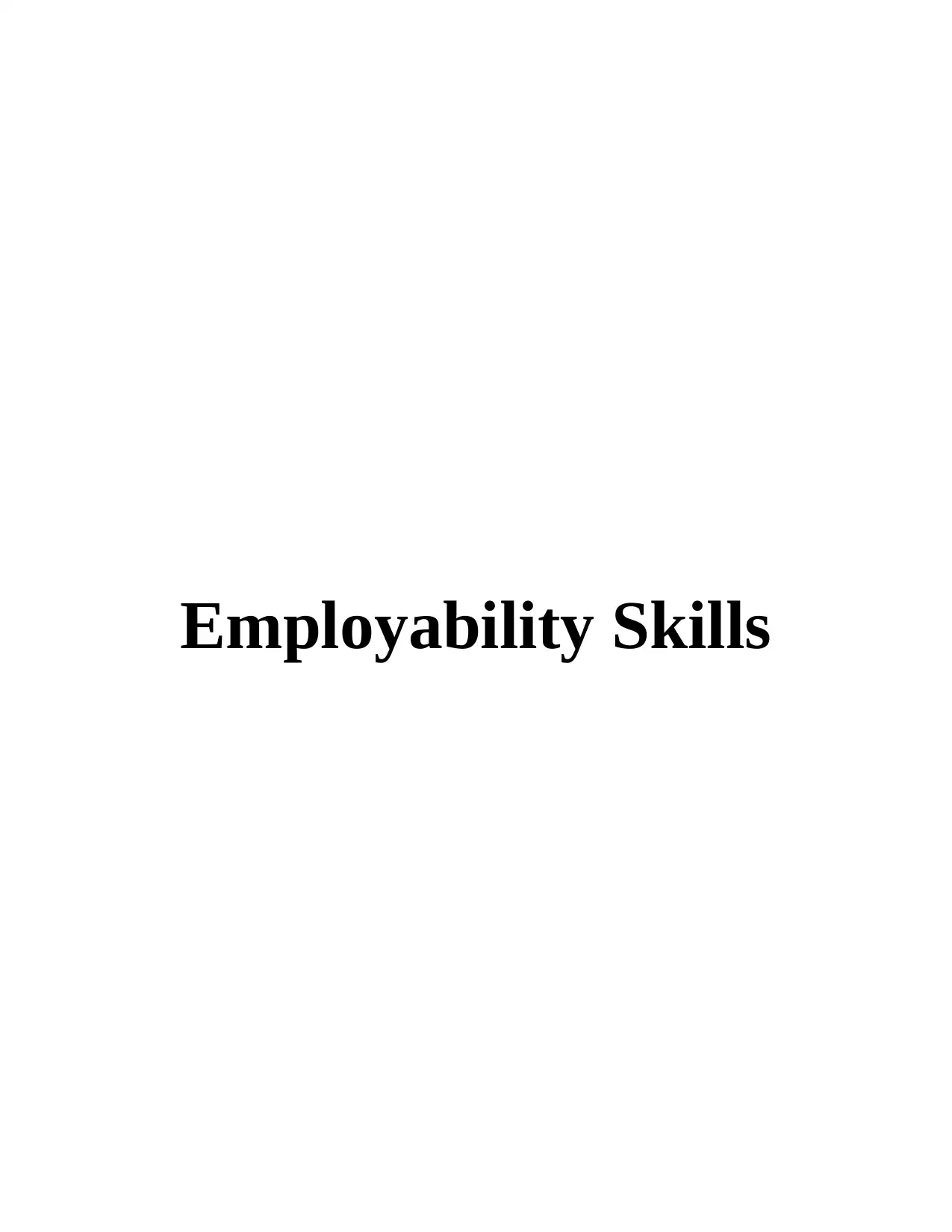
Employability Skills
Paraphrase This Document
Need a fresh take? Get an instant paraphrase of this document with our AI Paraphraser
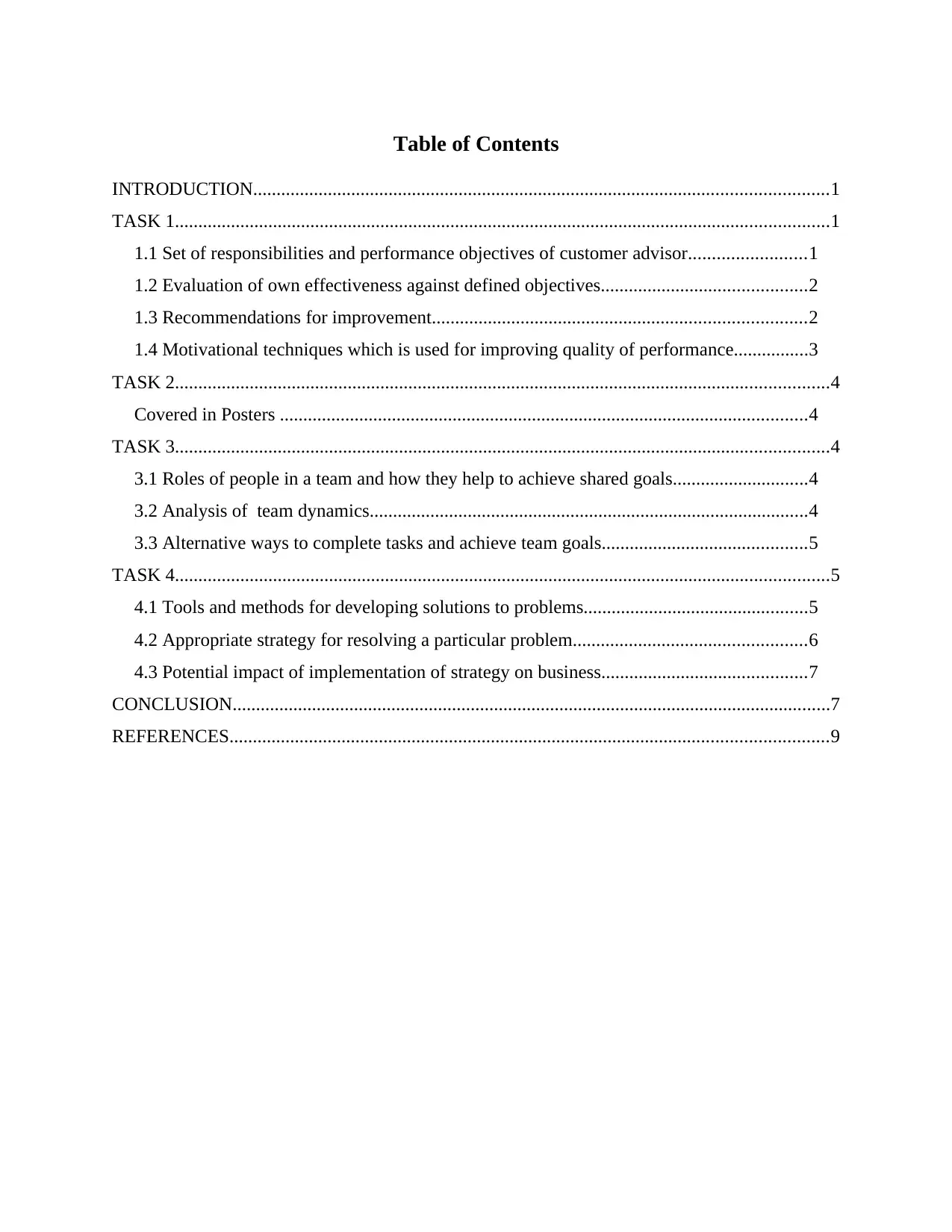
Table of Contents
INTRODUCTION...........................................................................................................................1
TASK 1............................................................................................................................................1
1.1 Set of responsibilities and performance objectives of customer advisor.........................1
1.2 Evaluation of own effectiveness against defined objectives............................................2
1.3 Recommendations for improvement................................................................................2
1.4 Motivational techniques which is used for improving quality of performance................3
TASK 2............................................................................................................................................4
Covered in Posters .................................................................................................................4
TASK 3............................................................................................................................................4
3.1 Roles of people in a team and how they help to achieve shared goals.............................4
3.2 Analysis of team dynamics..............................................................................................4
3.3 Alternative ways to complete tasks and achieve team goals............................................5
TASK 4............................................................................................................................................5
4.1 Tools and methods for developing solutions to problems................................................5
4.2 Appropriate strategy for resolving a particular problem..................................................6
4.3 Potential impact of implementation of strategy on business............................................7
CONCLUSION................................................................................................................................7
REFERENCES................................................................................................................................9
INTRODUCTION...........................................................................................................................1
TASK 1............................................................................................................................................1
1.1 Set of responsibilities and performance objectives of customer advisor.........................1
1.2 Evaluation of own effectiveness against defined objectives............................................2
1.3 Recommendations for improvement................................................................................2
1.4 Motivational techniques which is used for improving quality of performance................3
TASK 2............................................................................................................................................4
Covered in Posters .................................................................................................................4
TASK 3............................................................................................................................................4
3.1 Roles of people in a team and how they help to achieve shared goals.............................4
3.2 Analysis of team dynamics..............................................................................................4
3.3 Alternative ways to complete tasks and achieve team goals............................................5
TASK 4............................................................................................................................................5
4.1 Tools and methods for developing solutions to problems................................................5
4.2 Appropriate strategy for resolving a particular problem..................................................6
4.3 Potential impact of implementation of strategy on business............................................7
CONCLUSION................................................................................................................................7
REFERENCES................................................................................................................................9
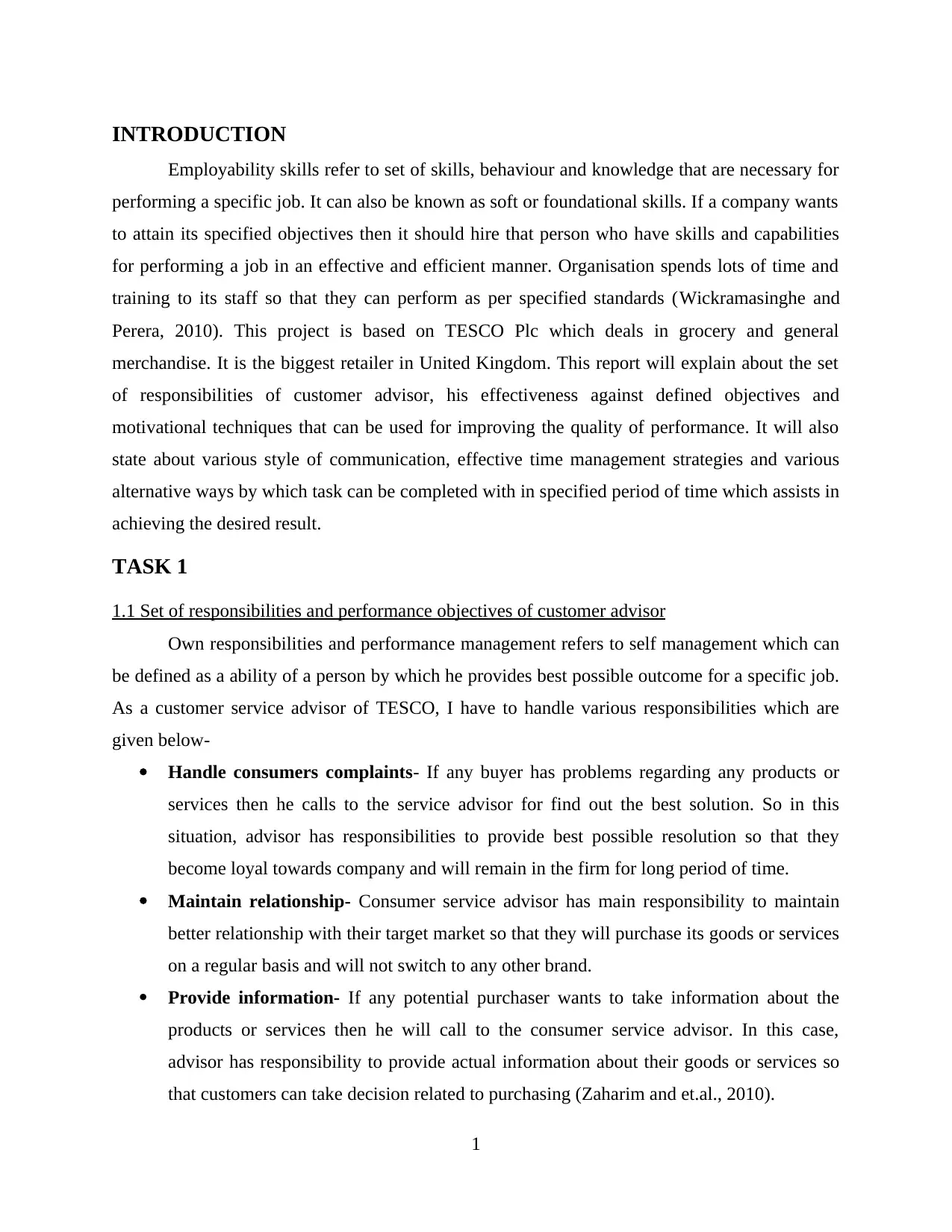
INTRODUCTION
Employability skills refer to set of skills, behaviour and knowledge that are necessary for
performing a specific job. It can also be known as soft or foundational skills. If a company wants
to attain its specified objectives then it should hire that person who have skills and capabilities
for performing a job in an effective and efficient manner. Organisation spends lots of time and
training to its staff so that they can perform as per specified standards (Wickramasinghe and
Perera, 2010). This project is based on TESCO Plc which deals in grocery and general
merchandise. It is the biggest retailer in United Kingdom. This report will explain about the set
of responsibilities of customer advisor, his effectiveness against defined objectives and
motivational techniques that can be used for improving the quality of performance. It will also
state about various style of communication, effective time management strategies and various
alternative ways by which task can be completed with in specified period of time which assists in
achieving the desired result.
TASK 1
1.1 Set of responsibilities and performance objectives of customer advisor
Own responsibilities and performance management refers to self management which can
be defined as a ability of a person by which he provides best possible outcome for a specific job.
As a customer service advisor of TESCO, I have to handle various responsibilities which are
given below-
Handle consumers complaints- If any buyer has problems regarding any products or
services then he calls to the service advisor for find out the best solution. So in this
situation, advisor has responsibilities to provide best possible resolution so that they
become loyal towards company and will remain in the firm for long period of time.
Maintain relationship- Consumer service advisor has main responsibility to maintain
better relationship with their target market so that they will purchase its goods or services
on a regular basis and will not switch to any other brand.
Provide information- If any potential purchaser wants to take information about the
products or services then he will call to the consumer service advisor. In this case,
advisor has responsibility to provide actual information about their goods or services so
that customers can take decision related to purchasing (Zaharim and et.al., 2010).
1
Employability skills refer to set of skills, behaviour and knowledge that are necessary for
performing a specific job. It can also be known as soft or foundational skills. If a company wants
to attain its specified objectives then it should hire that person who have skills and capabilities
for performing a job in an effective and efficient manner. Organisation spends lots of time and
training to its staff so that they can perform as per specified standards (Wickramasinghe and
Perera, 2010). This project is based on TESCO Plc which deals in grocery and general
merchandise. It is the biggest retailer in United Kingdom. This report will explain about the set
of responsibilities of customer advisor, his effectiveness against defined objectives and
motivational techniques that can be used for improving the quality of performance. It will also
state about various style of communication, effective time management strategies and various
alternative ways by which task can be completed with in specified period of time which assists in
achieving the desired result.
TASK 1
1.1 Set of responsibilities and performance objectives of customer advisor
Own responsibilities and performance management refers to self management which can
be defined as a ability of a person by which he provides best possible outcome for a specific job.
As a customer service advisor of TESCO, I have to handle various responsibilities which are
given below-
Handle consumers complaints- If any buyer has problems regarding any products or
services then he calls to the service advisor for find out the best solution. So in this
situation, advisor has responsibilities to provide best possible resolution so that they
become loyal towards company and will remain in the firm for long period of time.
Maintain relationship- Consumer service advisor has main responsibility to maintain
better relationship with their target market so that they will purchase its goods or services
on a regular basis and will not switch to any other brand.
Provide information- If any potential purchaser wants to take information about the
products or services then he will call to the consumer service advisor. In this case,
advisor has responsibility to provide actual information about their goods or services so
that customers can take decision related to purchasing (Zaharim and et.al., 2010).
1
⊘ This is a preview!⊘
Do you want full access?
Subscribe today to unlock all pages.

Trusted by 1+ million students worldwide
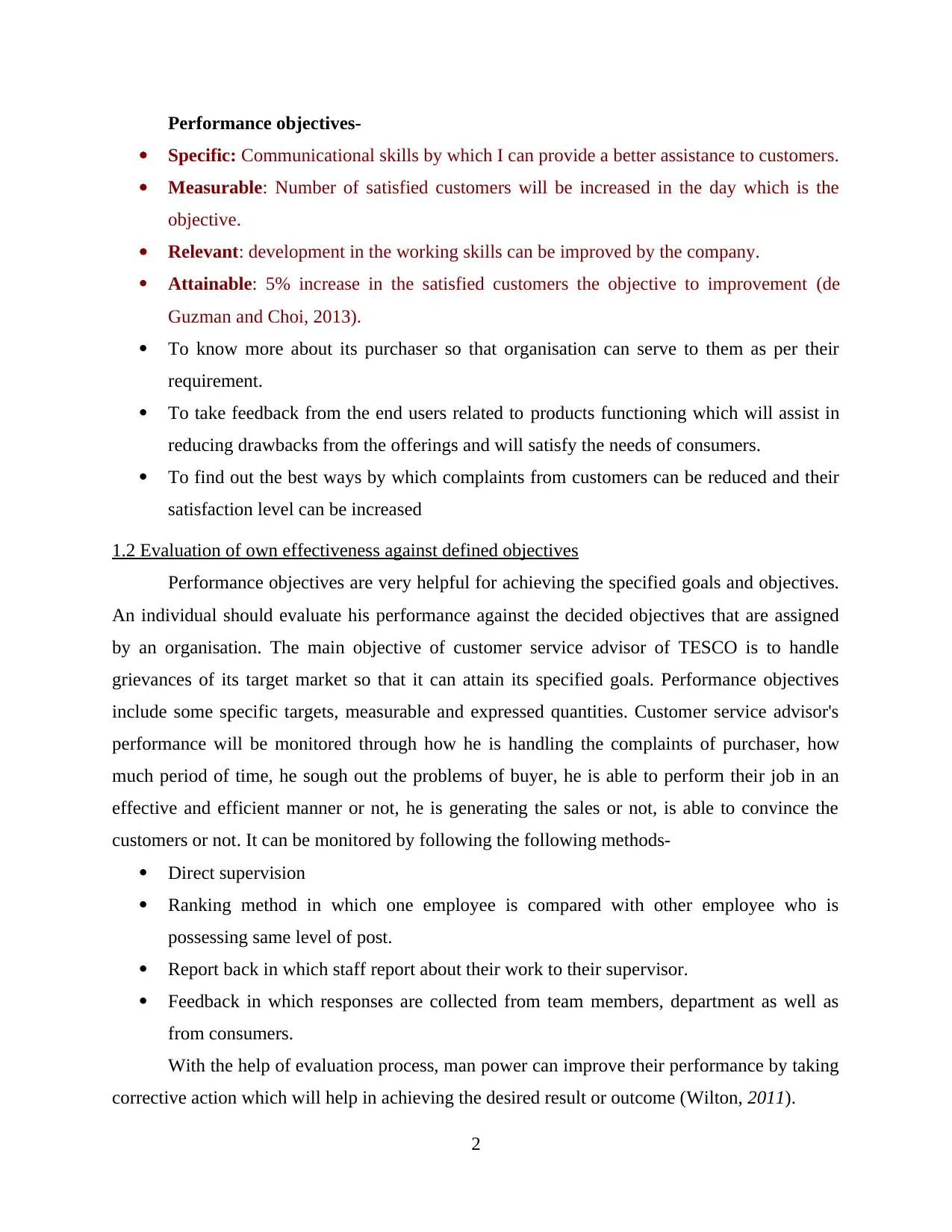
Performance objectives-
Specific: Communicational skills by which I can provide a better assistance to customers.
Measurable: Number of satisfied customers will be increased in the day which is the
objective.
Relevant: development in the working skills can be improved by the company.
Attainable: 5% increase in the satisfied customers the objective to improvement (de
Guzman and Choi, 2013).
To know more about its purchaser so that organisation can serve to them as per their
requirement.
To take feedback from the end users related to products functioning which will assist in
reducing drawbacks from the offerings and will satisfy the needs of consumers.
To find out the best ways by which complaints from customers can be reduced and their
satisfaction level can be increased
1.2 Evaluation of own effectiveness against defined objectives
Performance objectives are very helpful for achieving the specified goals and objectives.
An individual should evaluate his performance against the decided objectives that are assigned
by an organisation. The main objective of customer service advisor of TESCO is to handle
grievances of its target market so that it can attain its specified goals. Performance objectives
include some specific targets, measurable and expressed quantities. Customer service advisor's
performance will be monitored through how he is handling the complaints of purchaser, how
much period of time, he sough out the problems of buyer, he is able to perform their job in an
effective and efficient manner or not, he is generating the sales or not, is able to convince the
customers or not. It can be monitored by following the following methods-
Direct supervision
Ranking method in which one employee is compared with other employee who is
possessing same level of post.
Report back in which staff report about their work to their supervisor.
Feedback in which responses are collected from team members, department as well as
from consumers.
With the help of evaluation process, man power can improve their performance by taking
corrective action which will help in achieving the desired result or outcome (Wilton, 2011).
2
Specific: Communicational skills by which I can provide a better assistance to customers.
Measurable: Number of satisfied customers will be increased in the day which is the
objective.
Relevant: development in the working skills can be improved by the company.
Attainable: 5% increase in the satisfied customers the objective to improvement (de
Guzman and Choi, 2013).
To know more about its purchaser so that organisation can serve to them as per their
requirement.
To take feedback from the end users related to products functioning which will assist in
reducing drawbacks from the offerings and will satisfy the needs of consumers.
To find out the best ways by which complaints from customers can be reduced and their
satisfaction level can be increased
1.2 Evaluation of own effectiveness against defined objectives
Performance objectives are very helpful for achieving the specified goals and objectives.
An individual should evaluate his performance against the decided objectives that are assigned
by an organisation. The main objective of customer service advisor of TESCO is to handle
grievances of its target market so that it can attain its specified goals. Performance objectives
include some specific targets, measurable and expressed quantities. Customer service advisor's
performance will be monitored through how he is handling the complaints of purchaser, how
much period of time, he sough out the problems of buyer, he is able to perform their job in an
effective and efficient manner or not, he is generating the sales or not, is able to convince the
customers or not. It can be monitored by following the following methods-
Direct supervision
Ranking method in which one employee is compared with other employee who is
possessing same level of post.
Report back in which staff report about their work to their supervisor.
Feedback in which responses are collected from team members, department as well as
from consumers.
With the help of evaluation process, man power can improve their performance by taking
corrective action which will help in achieving the desired result or outcome (Wilton, 2011).
2
Paraphrase This Document
Need a fresh take? Get an instant paraphrase of this document with our AI Paraphraser
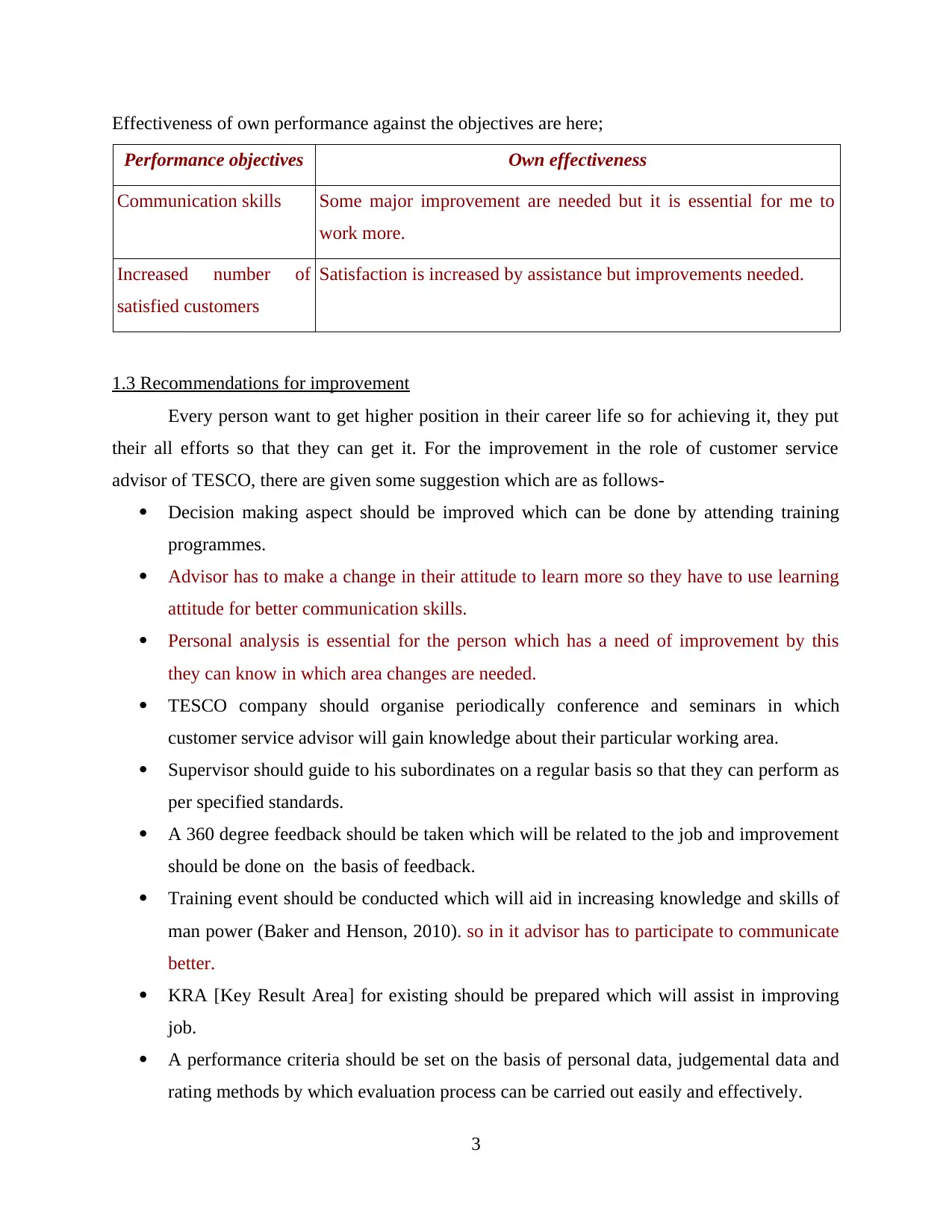
Effectiveness of own performance against the objectives are here;
Performance objectives Own effectiveness
Communication skills Some major improvement are needed but it is essential for me to
work more.
Increased number of
satisfied customers
Satisfaction is increased by assistance but improvements needed.
1.3 Recommendations for improvement
Every person want to get higher position in their career life so for achieving it, they put
their all efforts so that they can get it. For the improvement in the role of customer service
advisor of TESCO, there are given some suggestion which are as follows-
Decision making aspect should be improved which can be done by attending training
programmes.
Advisor has to make a change in their attitude to learn more so they have to use learning
attitude for better communication skills.
Personal analysis is essential for the person which has a need of improvement by this
they can know in which area changes are needed.
TESCO company should organise periodically conference and seminars in which
customer service advisor will gain knowledge about their particular working area.
Supervisor should guide to his subordinates on a regular basis so that they can perform as
per specified standards.
A 360 degree feedback should be taken which will be related to the job and improvement
should be done on the basis of feedback.
Training event should be conducted which will aid in increasing knowledge and skills of
man power (Baker and Henson, 2010). so in it advisor has to participate to communicate
better.
KRA [Key Result Area] for existing should be prepared which will assist in improving
job.
A performance criteria should be set on the basis of personal data, judgemental data and
rating methods by which evaluation process can be carried out easily and effectively.
3
Performance objectives Own effectiveness
Communication skills Some major improvement are needed but it is essential for me to
work more.
Increased number of
satisfied customers
Satisfaction is increased by assistance but improvements needed.
1.3 Recommendations for improvement
Every person want to get higher position in their career life so for achieving it, they put
their all efforts so that they can get it. For the improvement in the role of customer service
advisor of TESCO, there are given some suggestion which are as follows-
Decision making aspect should be improved which can be done by attending training
programmes.
Advisor has to make a change in their attitude to learn more so they have to use learning
attitude for better communication skills.
Personal analysis is essential for the person which has a need of improvement by this
they can know in which area changes are needed.
TESCO company should organise periodically conference and seminars in which
customer service advisor will gain knowledge about their particular working area.
Supervisor should guide to his subordinates on a regular basis so that they can perform as
per specified standards.
A 360 degree feedback should be taken which will be related to the job and improvement
should be done on the basis of feedback.
Training event should be conducted which will aid in increasing knowledge and skills of
man power (Baker and Henson, 2010). so in it advisor has to participate to communicate
better.
KRA [Key Result Area] for existing should be prepared which will assist in improving
job.
A performance criteria should be set on the basis of personal data, judgemental data and
rating methods by which evaluation process can be carried out easily and effectively.
3
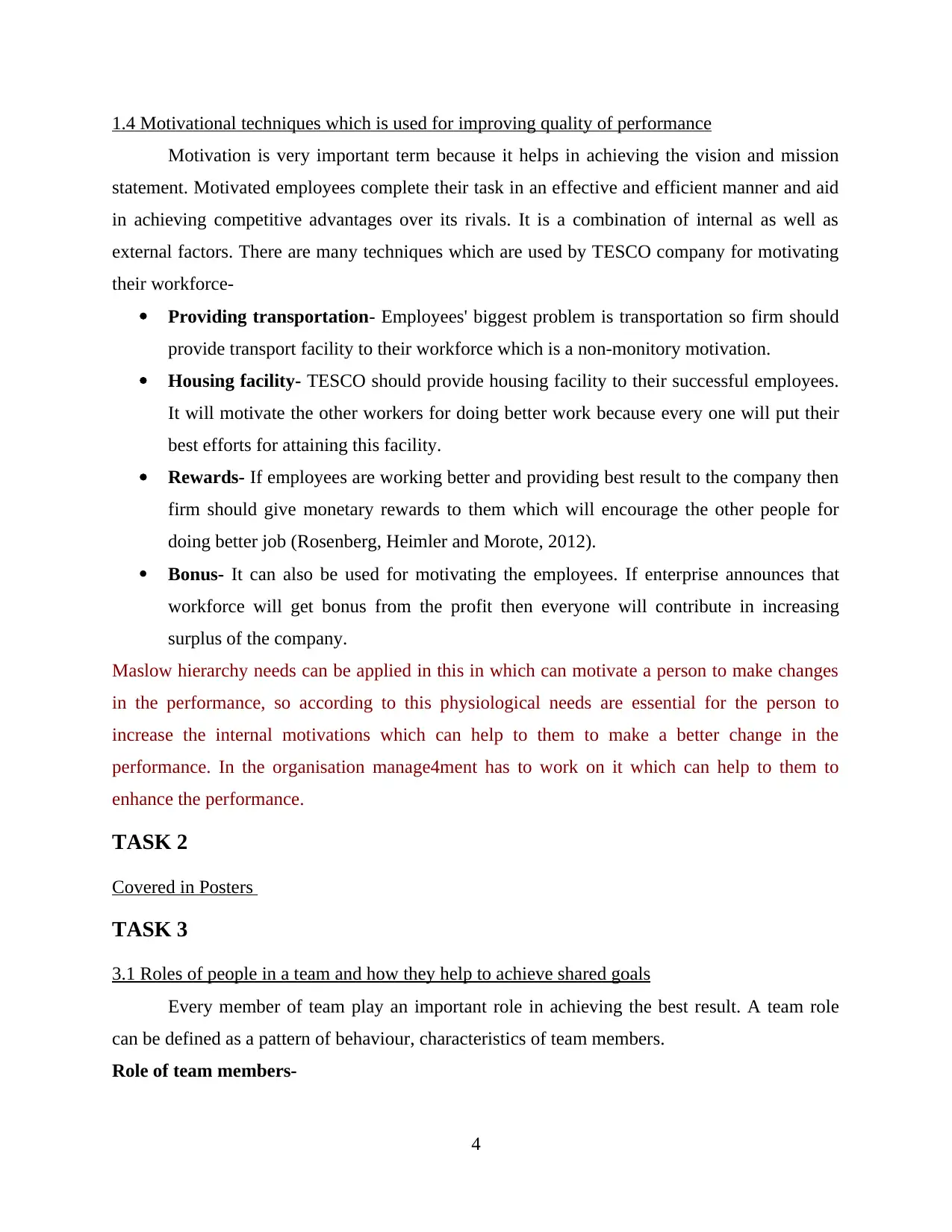
1.4 Motivational techniques which is used for improving quality of performance
Motivation is very important term because it helps in achieving the vision and mission
statement. Motivated employees complete their task in an effective and efficient manner and aid
in achieving competitive advantages over its rivals. It is a combination of internal as well as
external factors. There are many techniques which are used by TESCO company for motivating
their workforce-
Providing transportation- Employees' biggest problem is transportation so firm should
provide transport facility to their workforce which is a non-monitory motivation.
Housing facility- TESCO should provide housing facility to their successful employees.
It will motivate the other workers for doing better work because every one will put their
best efforts for attaining this facility.
Rewards- If employees are working better and providing best result to the company then
firm should give monetary rewards to them which will encourage the other people for
doing better job (Rosenberg, Heimler and Morote, 2012).
Bonus- It can also be used for motivating the employees. If enterprise announces that
workforce will get bonus from the profit then everyone will contribute in increasing
surplus of the company.
Maslow hierarchy needs can be applied in this in which can motivate a person to make changes
in the performance, so according to this physiological needs are essential for the person to
increase the internal motivations which can help to them to make a better change in the
performance. In the organisation manage4ment has to work on it which can help to them to
enhance the performance.
TASK 2
Covered in Posters
TASK 3
3.1 Roles of people in a team and how they help to achieve shared goals
Every member of team play an important role in achieving the best result. A team role
can be defined as a pattern of behaviour, characteristics of team members.
Role of team members-
4
Motivation is very important term because it helps in achieving the vision and mission
statement. Motivated employees complete their task in an effective and efficient manner and aid
in achieving competitive advantages over its rivals. It is a combination of internal as well as
external factors. There are many techniques which are used by TESCO company for motivating
their workforce-
Providing transportation- Employees' biggest problem is transportation so firm should
provide transport facility to their workforce which is a non-monitory motivation.
Housing facility- TESCO should provide housing facility to their successful employees.
It will motivate the other workers for doing better work because every one will put their
best efforts for attaining this facility.
Rewards- If employees are working better and providing best result to the company then
firm should give monetary rewards to them which will encourage the other people for
doing better job (Rosenberg, Heimler and Morote, 2012).
Bonus- It can also be used for motivating the employees. If enterprise announces that
workforce will get bonus from the profit then everyone will contribute in increasing
surplus of the company.
Maslow hierarchy needs can be applied in this in which can motivate a person to make changes
in the performance, so according to this physiological needs are essential for the person to
increase the internal motivations which can help to them to make a better change in the
performance. In the organisation manage4ment has to work on it which can help to them to
enhance the performance.
TASK 2
Covered in Posters
TASK 3
3.1 Roles of people in a team and how they help to achieve shared goals
Every member of team play an important role in achieving the best result. A team role
can be defined as a pattern of behaviour, characteristics of team members.
Role of team members-
4
⊘ This is a preview!⊘
Do you want full access?
Subscribe today to unlock all pages.

Trusted by 1+ million students worldwide
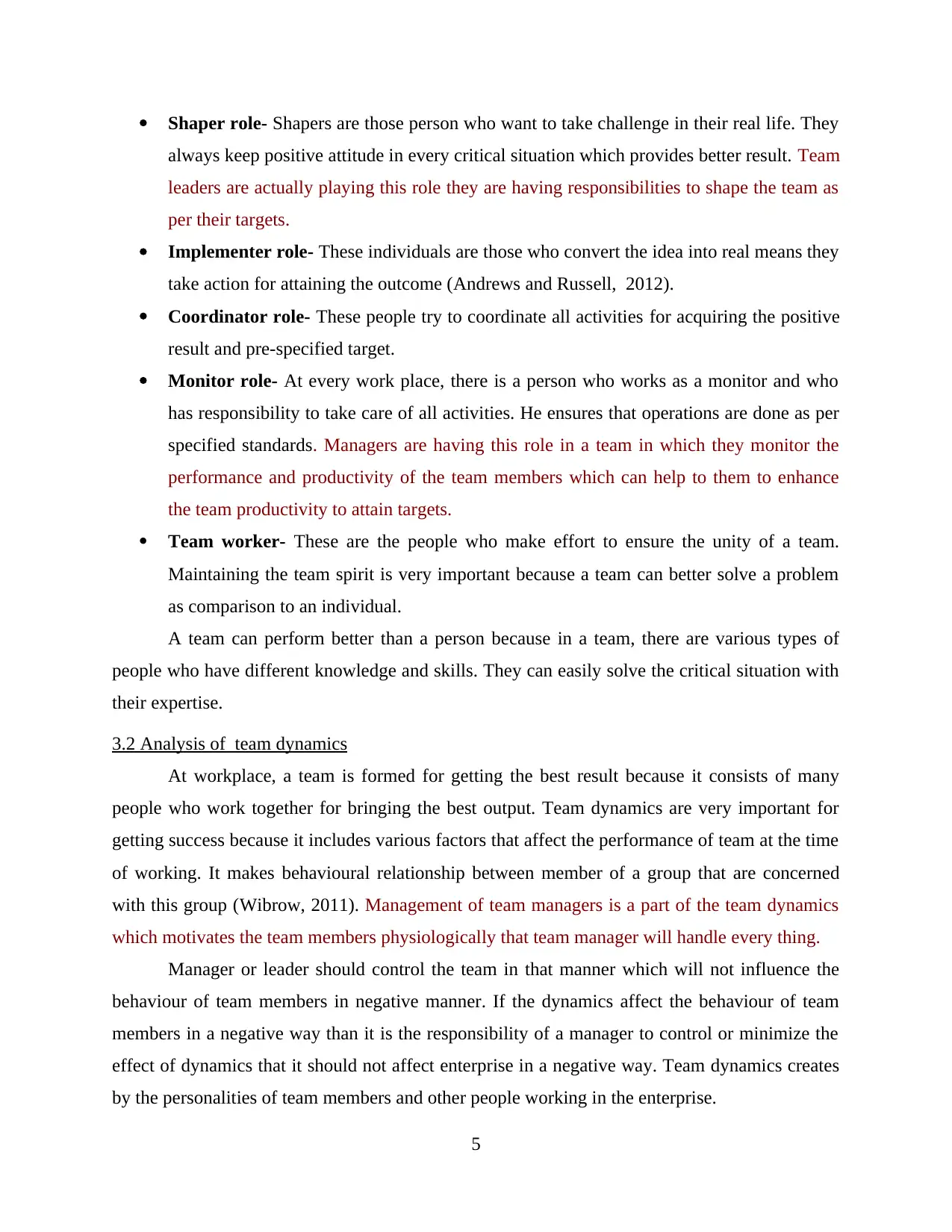
Shaper role- Shapers are those person who want to take challenge in their real life. They
always keep positive attitude in every critical situation which provides better result. Team
leaders are actually playing this role they are having responsibilities to shape the team as
per their targets.
Implementer role- These individuals are those who convert the idea into real means they
take action for attaining the outcome (Andrews and Russell, 2012).
Coordinator role- These people try to coordinate all activities for acquiring the positive
result and pre-specified target.
Monitor role- At every work place, there is a person who works as a monitor and who
has responsibility to take care of all activities. He ensures that operations are done as per
specified standards. Managers are having this role in a team in which they monitor the
performance and productivity of the team members which can help to them to enhance
the team productivity to attain targets.
Team worker- These are the people who make effort to ensure the unity of a team.
Maintaining the team spirit is very important because a team can better solve a problem
as comparison to an individual.
A team can perform better than a person because in a team, there are various types of
people who have different knowledge and skills. They can easily solve the critical situation with
their expertise.
3.2 Analysis of team dynamics
At workplace, a team is formed for getting the best result because it consists of many
people who work together for bringing the best output. Team dynamics are very important for
getting success because it includes various factors that affect the performance of team at the time
of working. It makes behavioural relationship between member of a group that are concerned
with this group (Wibrow, 2011). Management of team managers is a part of the team dynamics
which motivates the team members physiologically that team manager will handle every thing.
Manager or leader should control the team in that manner which will not influence the
behaviour of team members in negative manner. If the dynamics affect the behaviour of team
members in a negative way than it is the responsibility of a manager to control or minimize the
effect of dynamics that it should not affect enterprise in a negative way. Team dynamics creates
by the personalities of team members and other people working in the enterprise.
5
always keep positive attitude in every critical situation which provides better result. Team
leaders are actually playing this role they are having responsibilities to shape the team as
per their targets.
Implementer role- These individuals are those who convert the idea into real means they
take action for attaining the outcome (Andrews and Russell, 2012).
Coordinator role- These people try to coordinate all activities for acquiring the positive
result and pre-specified target.
Monitor role- At every work place, there is a person who works as a monitor and who
has responsibility to take care of all activities. He ensures that operations are done as per
specified standards. Managers are having this role in a team in which they monitor the
performance and productivity of the team members which can help to them to enhance
the team productivity to attain targets.
Team worker- These are the people who make effort to ensure the unity of a team.
Maintaining the team spirit is very important because a team can better solve a problem
as comparison to an individual.
A team can perform better than a person because in a team, there are various types of
people who have different knowledge and skills. They can easily solve the critical situation with
their expertise.
3.2 Analysis of team dynamics
At workplace, a team is formed for getting the best result because it consists of many
people who work together for bringing the best output. Team dynamics are very important for
getting success because it includes various factors that affect the performance of team at the time
of working. It makes behavioural relationship between member of a group that are concerned
with this group (Wibrow, 2011). Management of team managers is a part of the team dynamics
which motivates the team members physiologically that team manager will handle every thing.
Manager or leader should control the team in that manner which will not influence the
behaviour of team members in negative manner. If the dynamics affect the behaviour of team
members in a negative way than it is the responsibility of a manager to control or minimize the
effect of dynamics that it should not affect enterprise in a negative way. Team dynamics creates
by the personalities of team members and other people working in the enterprise.
5
Paraphrase This Document
Need a fresh take? Get an instant paraphrase of this document with our AI Paraphraser
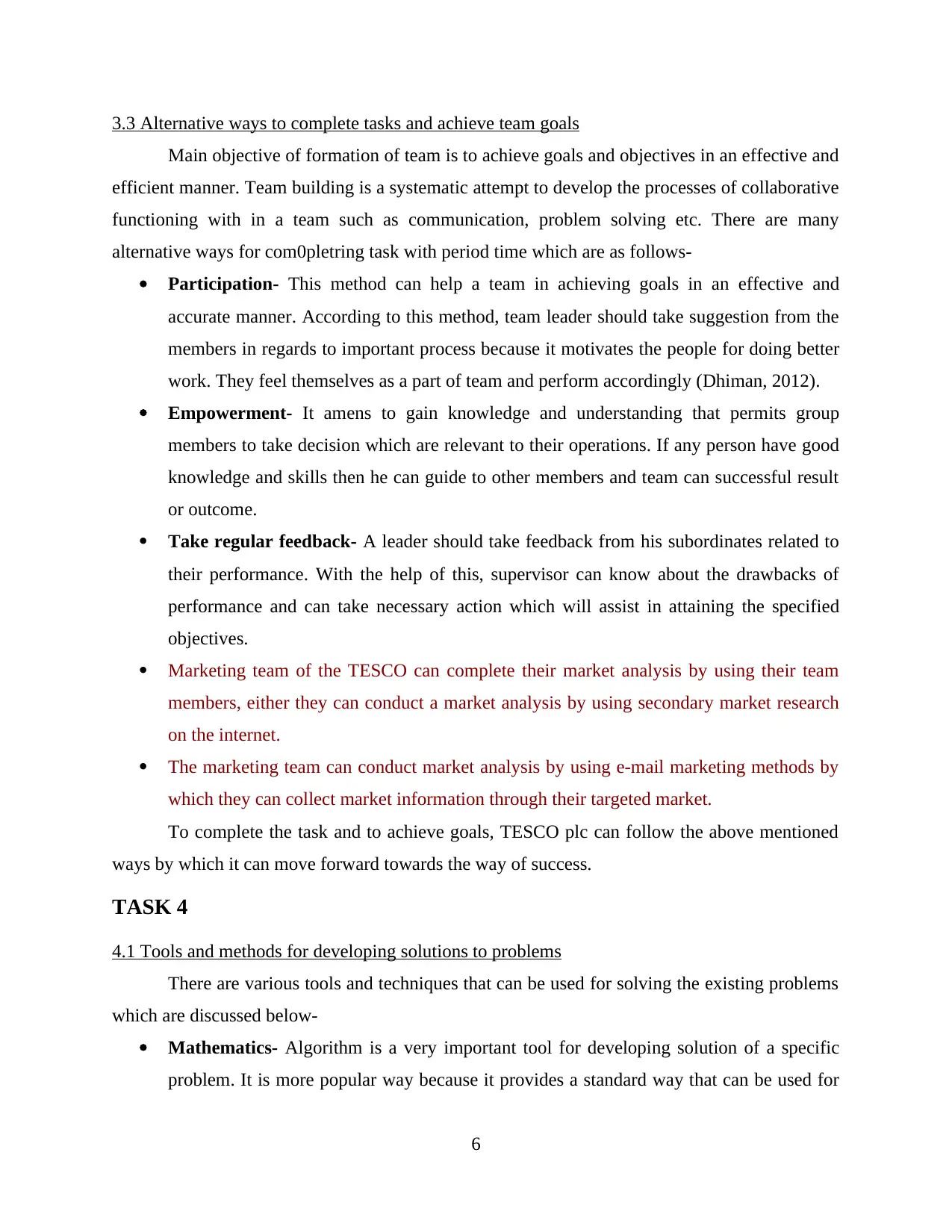
3.3 Alternative ways to complete tasks and achieve team goals
Main objective of formation of team is to achieve goals and objectives in an effective and
efficient manner. Team building is a systematic attempt to develop the processes of collaborative
functioning with in a team such as communication, problem solving etc. There are many
alternative ways for com0pletring task with period time which are as follows-
Participation- This method can help a team in achieving goals in an effective and
accurate manner. According to this method, team leader should take suggestion from the
members in regards to important process because it motivates the people for doing better
work. They feel themselves as a part of team and perform accordingly (Dhiman, 2012).
Empowerment- It amens to gain knowledge and understanding that permits group
members to take decision which are relevant to their operations. If any person have good
knowledge and skills then he can guide to other members and team can successful result
or outcome.
Take regular feedback- A leader should take feedback from his subordinates related to
their performance. With the help of this, supervisor can know about the drawbacks of
performance and can take necessary action which will assist in attaining the specified
objectives.
Marketing team of the TESCO can complete their market analysis by using their team
members, either they can conduct a market analysis by using secondary market research
on the internet.
The marketing team can conduct market analysis by using e-mail marketing methods by
which they can collect market information through their targeted market.
To complete the task and to achieve goals, TESCO plc can follow the above mentioned
ways by which it can move forward towards the way of success.
TASK 4
4.1 Tools and methods for developing solutions to problems
There are various tools and techniques that can be used for solving the existing problems
which are discussed below-
Mathematics- Algorithm is a very important tool for developing solution of a specific
problem. It is more popular way because it provides a standard way that can be used for
6
Main objective of formation of team is to achieve goals and objectives in an effective and
efficient manner. Team building is a systematic attempt to develop the processes of collaborative
functioning with in a team such as communication, problem solving etc. There are many
alternative ways for com0pletring task with period time which are as follows-
Participation- This method can help a team in achieving goals in an effective and
accurate manner. According to this method, team leader should take suggestion from the
members in regards to important process because it motivates the people for doing better
work. They feel themselves as a part of team and perform accordingly (Dhiman, 2012).
Empowerment- It amens to gain knowledge and understanding that permits group
members to take decision which are relevant to their operations. If any person have good
knowledge and skills then he can guide to other members and team can successful result
or outcome.
Take regular feedback- A leader should take feedback from his subordinates related to
their performance. With the help of this, supervisor can know about the drawbacks of
performance and can take necessary action which will assist in attaining the specified
objectives.
Marketing team of the TESCO can complete their market analysis by using their team
members, either they can conduct a market analysis by using secondary market research
on the internet.
The marketing team can conduct market analysis by using e-mail marketing methods by
which they can collect market information through their targeted market.
To complete the task and to achieve goals, TESCO plc can follow the above mentioned
ways by which it can move forward towards the way of success.
TASK 4
4.1 Tools and methods for developing solutions to problems
There are various tools and techniques that can be used for solving the existing problems
which are discussed below-
Mathematics- Algorithm is a very important tool for developing solution of a specific
problem. It is more popular way because it provides a standard way that can be used for
6
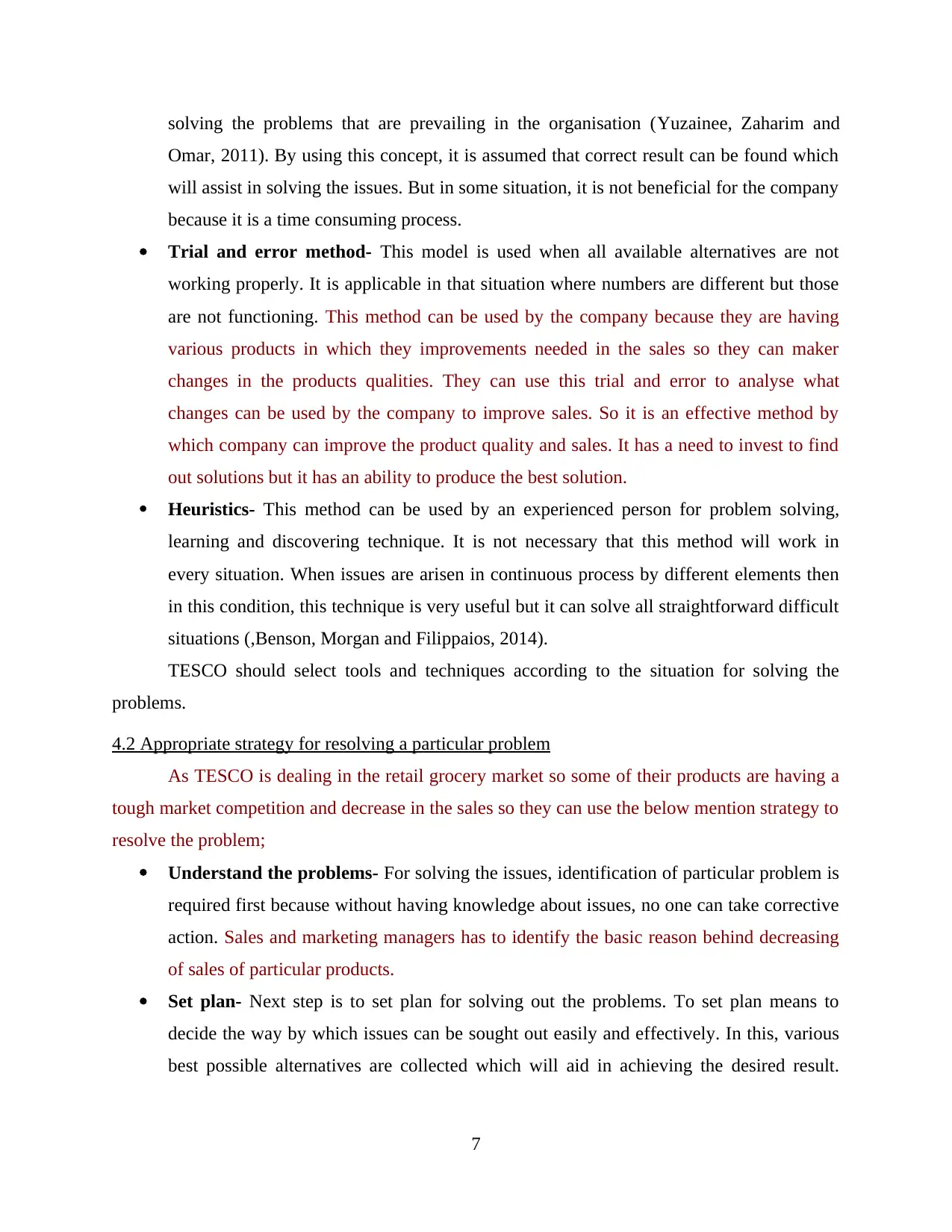
solving the problems that are prevailing in the organisation (Yuzainee, Zaharim and
Omar, 2011). By using this concept, it is assumed that correct result can be found which
will assist in solving the issues. But in some situation, it is not beneficial for the company
because it is a time consuming process.
Trial and error method- This model is used when all available alternatives are not
working properly. It is applicable in that situation where numbers are different but those
are not functioning. This method can be used by the company because they are having
various products in which they improvements needed in the sales so they can maker
changes in the products qualities. They can use this trial and error to analyse what
changes can be used by the company to improve sales. So it is an effective method by
which company can improve the product quality and sales. It has a need to invest to find
out solutions but it has an ability to produce the best solution.
Heuristics- This method can be used by an experienced person for problem solving,
learning and discovering technique. It is not necessary that this method will work in
every situation. When issues are arisen in continuous process by different elements then
in this condition, this technique is very useful but it can solve all straightforward difficult
situations (,Benson, Morgan and Filippaios, 2014).
TESCO should select tools and techniques according to the situation for solving the
problems.
4.2 Appropriate strategy for resolving a particular problem
As TESCO is dealing in the retail grocery market so some of their products are having a
tough market competition and decrease in the sales so they can use the below mention strategy to
resolve the problem;
Understand the problems- For solving the issues, identification of particular problem is
required first because without having knowledge about issues, no one can take corrective
action. Sales and marketing managers has to identify the basic reason behind decreasing
of sales of particular products.
Set plan- Next step is to set plan for solving out the problems. To set plan means to
decide the way by which issues can be sought out easily and effectively. In this, various
best possible alternatives are collected which will aid in achieving the desired result.
7
Omar, 2011). By using this concept, it is assumed that correct result can be found which
will assist in solving the issues. But in some situation, it is not beneficial for the company
because it is a time consuming process.
Trial and error method- This model is used when all available alternatives are not
working properly. It is applicable in that situation where numbers are different but those
are not functioning. This method can be used by the company because they are having
various products in which they improvements needed in the sales so they can maker
changes in the products qualities. They can use this trial and error to analyse what
changes can be used by the company to improve sales. So it is an effective method by
which company can improve the product quality and sales. It has a need to invest to find
out solutions but it has an ability to produce the best solution.
Heuristics- This method can be used by an experienced person for problem solving,
learning and discovering technique. It is not necessary that this method will work in
every situation. When issues are arisen in continuous process by different elements then
in this condition, this technique is very useful but it can solve all straightforward difficult
situations (,Benson, Morgan and Filippaios, 2014).
TESCO should select tools and techniques according to the situation for solving the
problems.
4.2 Appropriate strategy for resolving a particular problem
As TESCO is dealing in the retail grocery market so some of their products are having a
tough market competition and decrease in the sales so they can use the below mention strategy to
resolve the problem;
Understand the problems- For solving the issues, identification of particular problem is
required first because without having knowledge about issues, no one can take corrective
action. Sales and marketing managers has to identify the basic reason behind decreasing
of sales of particular products.
Set plan- Next step is to set plan for solving out the problems. To set plan means to
decide the way by which issues can be sought out easily and effectively. In this, various
best possible alternatives are collected which will aid in achieving the desired result.
7
⊘ This is a preview!⊘
Do you want full access?
Subscribe today to unlock all pages.

Trusted by 1+ million students worldwide
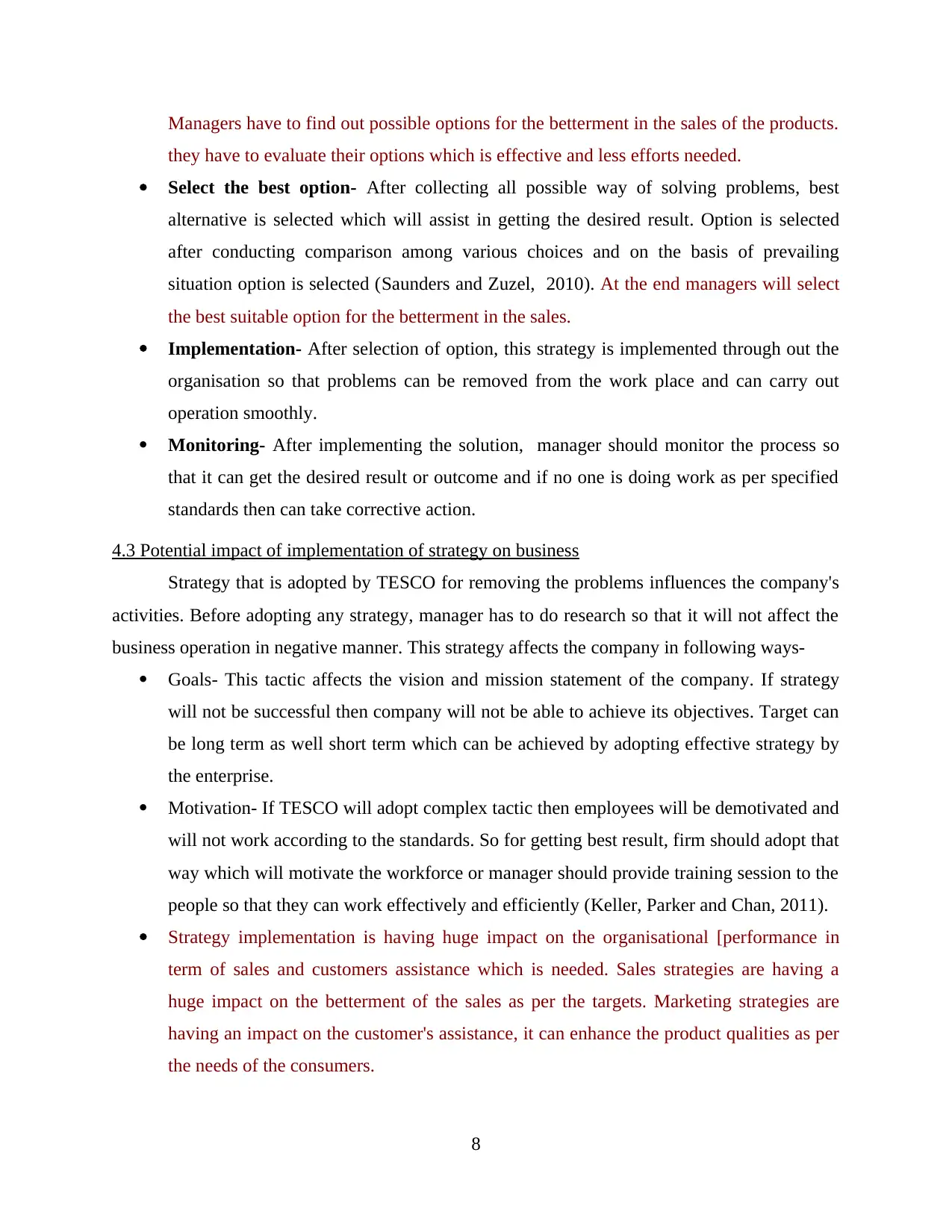
Managers have to find out possible options for the betterment in the sales of the products.
they have to evaluate their options which is effective and less efforts needed.
Select the best option- After collecting all possible way of solving problems, best
alternative is selected which will assist in getting the desired result. Option is selected
after conducting comparison among various choices and on the basis of prevailing
situation option is selected (Saunders and Zuzel, 2010). At the end managers will select
the best suitable option for the betterment in the sales.
Implementation- After selection of option, this strategy is implemented through out the
organisation so that problems can be removed from the work place and can carry out
operation smoothly.
Monitoring- After implementing the solution, manager should monitor the process so
that it can get the desired result or outcome and if no one is doing work as per specified
standards then can take corrective action.
4.3 Potential impact of implementation of strategy on business
Strategy that is adopted by TESCO for removing the problems influences the company's
activities. Before adopting any strategy, manager has to do research so that it will not affect the
business operation in negative manner. This strategy affects the company in following ways-
Goals- This tactic affects the vision and mission statement of the company. If strategy
will not be successful then company will not be able to achieve its objectives. Target can
be long term as well short term which can be achieved by adopting effective strategy by
the enterprise.
Motivation- If TESCO will adopt complex tactic then employees will be demotivated and
will not work according to the standards. So for getting best result, firm should adopt that
way which will motivate the workforce or manager should provide training session to the
people so that they can work effectively and efficiently (Keller, Parker and Chan, 2011).
Strategy implementation is having huge impact on the organisational [performance in
term of sales and customers assistance which is needed. Sales strategies are having a
huge impact on the betterment of the sales as per the targets. Marketing strategies are
having an impact on the customer's assistance, it can enhance the product qualities as per
the needs of the consumers.
8
they have to evaluate their options which is effective and less efforts needed.
Select the best option- After collecting all possible way of solving problems, best
alternative is selected which will assist in getting the desired result. Option is selected
after conducting comparison among various choices and on the basis of prevailing
situation option is selected (Saunders and Zuzel, 2010). At the end managers will select
the best suitable option for the betterment in the sales.
Implementation- After selection of option, this strategy is implemented through out the
organisation so that problems can be removed from the work place and can carry out
operation smoothly.
Monitoring- After implementing the solution, manager should monitor the process so
that it can get the desired result or outcome and if no one is doing work as per specified
standards then can take corrective action.
4.3 Potential impact of implementation of strategy on business
Strategy that is adopted by TESCO for removing the problems influences the company's
activities. Before adopting any strategy, manager has to do research so that it will not affect the
business operation in negative manner. This strategy affects the company in following ways-
Goals- This tactic affects the vision and mission statement of the company. If strategy
will not be successful then company will not be able to achieve its objectives. Target can
be long term as well short term which can be achieved by adopting effective strategy by
the enterprise.
Motivation- If TESCO will adopt complex tactic then employees will be demotivated and
will not work according to the standards. So for getting best result, firm should adopt that
way which will motivate the workforce or manager should provide training session to the
people so that they can work effectively and efficiently (Keller, Parker and Chan, 2011).
Strategy implementation is having huge impact on the organisational [performance in
term of sales and customers assistance which is needed. Sales strategies are having a
huge impact on the betterment of the sales as per the targets. Marketing strategies are
having an impact on the customer's assistance, it can enhance the product qualities as per
the needs of the consumers.
8
Paraphrase This Document
Need a fresh take? Get an instant paraphrase of this document with our AI Paraphraser
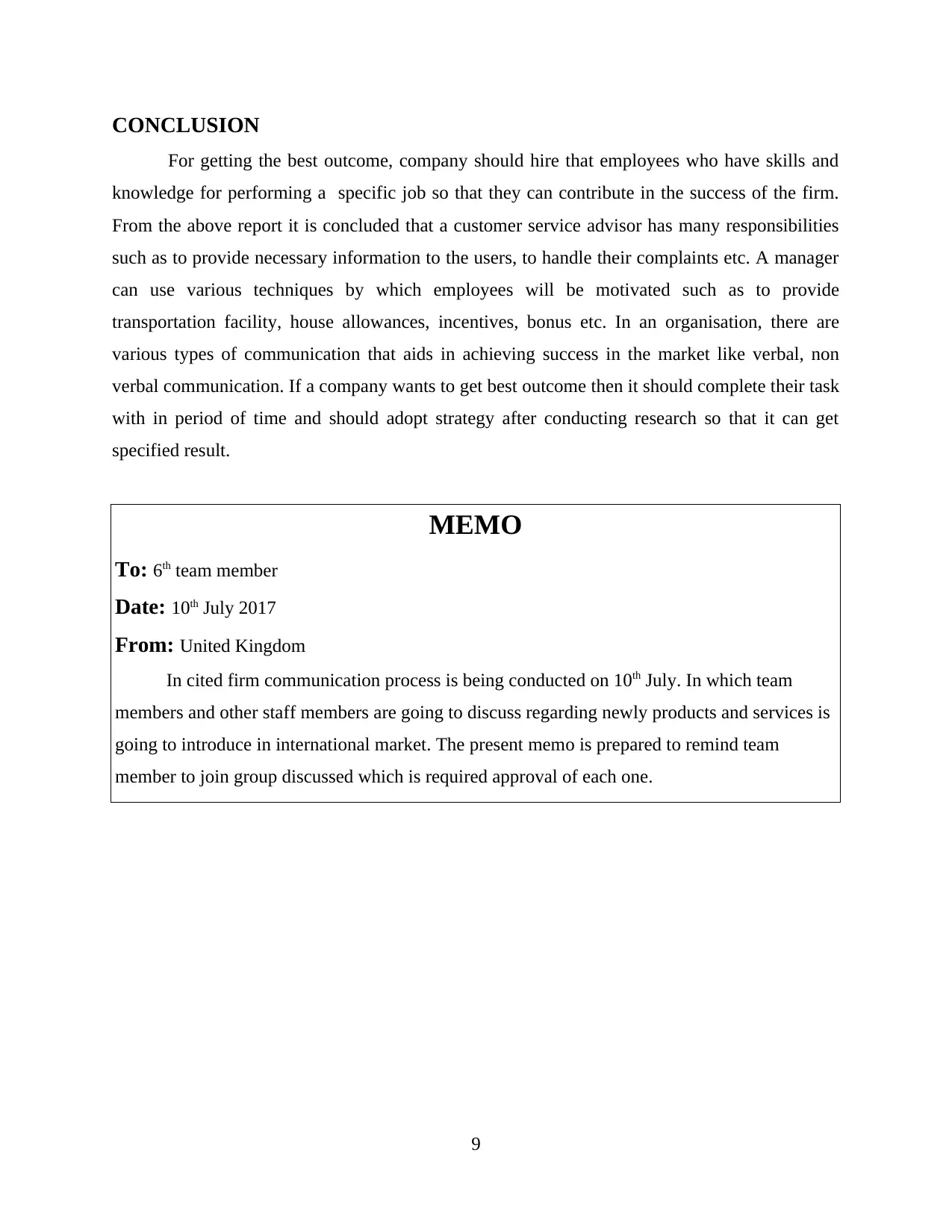
CONCLUSION
For getting the best outcome, company should hire that employees who have skills and
knowledge for performing a specific job so that they can contribute in the success of the firm.
From the above report it is concluded that a customer service advisor has many responsibilities
such as to provide necessary information to the users, to handle their complaints etc. A manager
can use various techniques by which employees will be motivated such as to provide
transportation facility, house allowances, incentives, bonus etc. In an organisation, there are
various types of communication that aids in achieving success in the market like verbal, non
verbal communication. If a company wants to get best outcome then it should complete their task
with in period of time and should adopt strategy after conducting research so that it can get
specified result.
MEMO
To: 6th team member
Date: 10th July 2017
From: United Kingdom
In cited firm communication process is being conducted on 10th July. In which team
members and other staff members are going to discuss regarding newly products and services is
going to introduce in international market. The present memo is prepared to remind team
member to join group discussed which is required approval of each one.
9
For getting the best outcome, company should hire that employees who have skills and
knowledge for performing a specific job so that they can contribute in the success of the firm.
From the above report it is concluded that a customer service advisor has many responsibilities
such as to provide necessary information to the users, to handle their complaints etc. A manager
can use various techniques by which employees will be motivated such as to provide
transportation facility, house allowances, incentives, bonus etc. In an organisation, there are
various types of communication that aids in achieving success in the market like verbal, non
verbal communication. If a company wants to get best outcome then it should complete their task
with in period of time and should adopt strategy after conducting research so that it can get
specified result.
MEMO
To: 6th team member
Date: 10th July 2017
From: United Kingdom
In cited firm communication process is being conducted on 10th July. In which team
members and other staff members are going to discuss regarding newly products and services is
going to introduce in international market. The present memo is prepared to remind team
member to join group discussed which is required approval of each one.
9
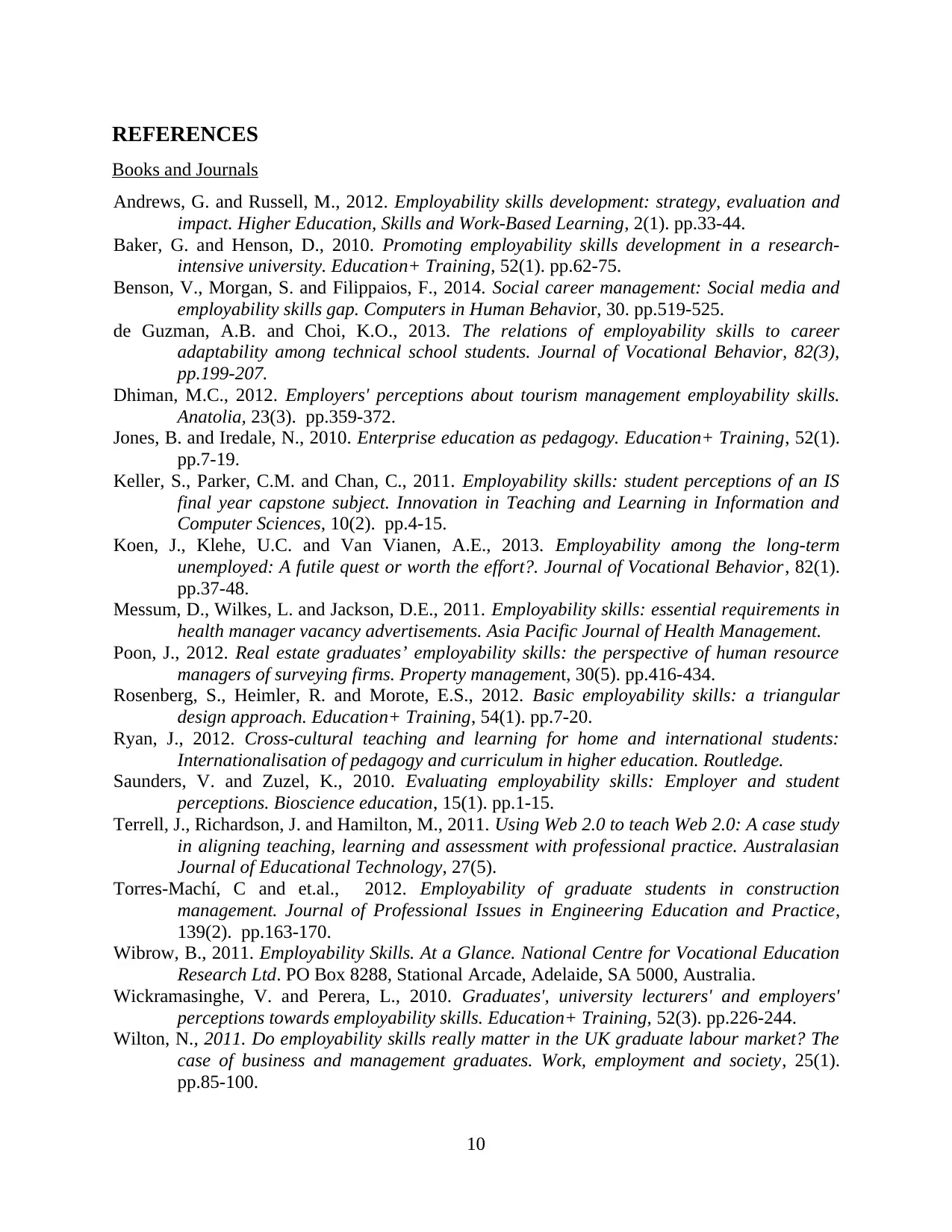
REFERENCES
Books and Journals
Andrews, G. and Russell, M., 2012. Employability skills development: strategy, evaluation and
impact. Higher Education, Skills and Work-Based Learning, 2(1). pp.33-44.
Baker, G. and Henson, D., 2010. Promoting employability skills development in a research-
intensive university. Education+ Training, 52(1). pp.62-75.
Benson, V., Morgan, S. and Filippaios, F., 2014. Social career management: Social media and
employability skills gap. Computers in Human Behavior, 30. pp.519-525.
de Guzman, A.B. and Choi, K.O., 2013. The relations of employability skills to career
adaptability among technical school students. Journal of Vocational Behavior, 82(3),
pp.199-207.
Dhiman, M.C., 2012. Employers' perceptions about tourism management employability skills.
Anatolia, 23(3). pp.359-372.
Jones, B. and Iredale, N., 2010. Enterprise education as pedagogy. Education+ Training, 52(1).
pp.7-19.
Keller, S., Parker, C.M. and Chan, C., 2011. Employability skills: student perceptions of an IS
final year capstone subject. Innovation in Teaching and Learning in Information and
Computer Sciences, 10(2). pp.4-15.
Koen, J., Klehe, U.C. and Van Vianen, A.E., 2013. Employability among the long-term
unemployed: A futile quest or worth the effort?. Journal of Vocational Behavior, 82(1).
pp.37-48.
Messum, D., Wilkes, L. and Jackson, D.E., 2011. Employability skills: essential requirements in
health manager vacancy advertisements. Asia Pacific Journal of Health Management.
Poon, J., 2012. Real estate graduates’ employability skills: the perspective of human resource
managers of surveying firms. Property management, 30(5). pp.416-434.
Rosenberg, S., Heimler, R. and Morote, E.S., 2012. Basic employability skills: a triangular
design approach. Education+ Training, 54(1). pp.7-20.
Ryan, J., 2012. Cross-cultural teaching and learning for home and international students:
Internationalisation of pedagogy and curriculum in higher education. Routledge.
Saunders, V. and Zuzel, K., 2010. Evaluating employability skills: Employer and student
perceptions. Bioscience education, 15(1). pp.1-15.
Terrell, J., Richardson, J. and Hamilton, M., 2011. Using Web 2.0 to teach Web 2.0: A case study
in aligning teaching, learning and assessment with professional practice. Australasian
Journal of Educational Technology, 27(5).
Torres-Machí, C and et.al., 2012. Employability of graduate students in construction
management. Journal of Professional Issues in Engineering Education and Practice,
139(2). pp.163-170.
Wibrow, B., 2011. Employability Skills. At a Glance. National Centre for Vocational Education
Research Ltd. PO Box 8288, Stational Arcade, Adelaide, SA 5000, Australia.
Wickramasinghe, V. and Perera, L., 2010. Graduates', university lecturers' and employers'
perceptions towards employability skills. Education+ Training, 52(3). pp.226-244.
Wilton, N., 2011. Do employability skills really matter in the UK graduate labour market? The
case of business and management graduates. Work, employment and society, 25(1).
pp.85-100.
10
Books and Journals
Andrews, G. and Russell, M., 2012. Employability skills development: strategy, evaluation and
impact. Higher Education, Skills and Work-Based Learning, 2(1). pp.33-44.
Baker, G. and Henson, D., 2010. Promoting employability skills development in a research-
intensive university. Education+ Training, 52(1). pp.62-75.
Benson, V., Morgan, S. and Filippaios, F., 2014. Social career management: Social media and
employability skills gap. Computers in Human Behavior, 30. pp.519-525.
de Guzman, A.B. and Choi, K.O., 2013. The relations of employability skills to career
adaptability among technical school students. Journal of Vocational Behavior, 82(3),
pp.199-207.
Dhiman, M.C., 2012. Employers' perceptions about tourism management employability skills.
Anatolia, 23(3). pp.359-372.
Jones, B. and Iredale, N., 2010. Enterprise education as pedagogy. Education+ Training, 52(1).
pp.7-19.
Keller, S., Parker, C.M. and Chan, C., 2011. Employability skills: student perceptions of an IS
final year capstone subject. Innovation in Teaching and Learning in Information and
Computer Sciences, 10(2). pp.4-15.
Koen, J., Klehe, U.C. and Van Vianen, A.E., 2013. Employability among the long-term
unemployed: A futile quest or worth the effort?. Journal of Vocational Behavior, 82(1).
pp.37-48.
Messum, D., Wilkes, L. and Jackson, D.E., 2011. Employability skills: essential requirements in
health manager vacancy advertisements. Asia Pacific Journal of Health Management.
Poon, J., 2012. Real estate graduates’ employability skills: the perspective of human resource
managers of surveying firms. Property management, 30(5). pp.416-434.
Rosenberg, S., Heimler, R. and Morote, E.S., 2012. Basic employability skills: a triangular
design approach. Education+ Training, 54(1). pp.7-20.
Ryan, J., 2012. Cross-cultural teaching and learning for home and international students:
Internationalisation of pedagogy and curriculum in higher education. Routledge.
Saunders, V. and Zuzel, K., 2010. Evaluating employability skills: Employer and student
perceptions. Bioscience education, 15(1). pp.1-15.
Terrell, J., Richardson, J. and Hamilton, M., 2011. Using Web 2.0 to teach Web 2.0: A case study
in aligning teaching, learning and assessment with professional practice. Australasian
Journal of Educational Technology, 27(5).
Torres-Machí, C and et.al., 2012. Employability of graduate students in construction
management. Journal of Professional Issues in Engineering Education and Practice,
139(2). pp.163-170.
Wibrow, B., 2011. Employability Skills. At a Glance. National Centre for Vocational Education
Research Ltd. PO Box 8288, Stational Arcade, Adelaide, SA 5000, Australia.
Wickramasinghe, V. and Perera, L., 2010. Graduates', university lecturers' and employers'
perceptions towards employability skills. Education+ Training, 52(3). pp.226-244.
Wilton, N., 2011. Do employability skills really matter in the UK graduate labour market? The
case of business and management graduates. Work, employment and society, 25(1).
pp.85-100.
10
⊘ This is a preview!⊘
Do you want full access?
Subscribe today to unlock all pages.

Trusted by 1+ million students worldwide
1 out of 13
Related Documents
Your All-in-One AI-Powered Toolkit for Academic Success.
+13062052269
info@desklib.com
Available 24*7 on WhatsApp / Email
![[object Object]](/_next/static/media/star-bottom.7253800d.svg)
Unlock your academic potential
Copyright © 2020–2025 A2Z Services. All Rights Reserved. Developed and managed by ZUCOL.





